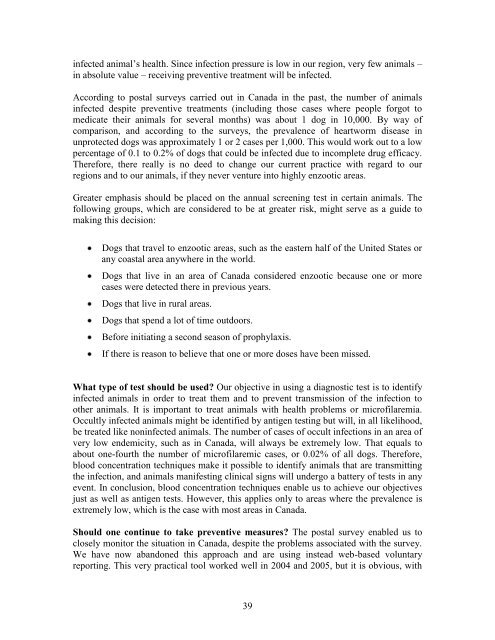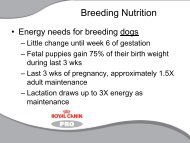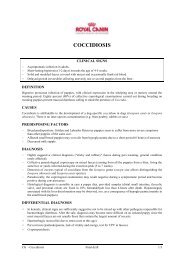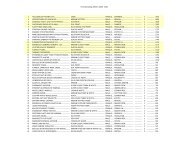Guide to Preventing Parasites.pdf - Royal Canin Canada
Guide to Preventing Parasites.pdf - Royal Canin Canada
Guide to Preventing Parasites.pdf - Royal Canin Canada
You also want an ePaper? Increase the reach of your titles
YUMPU automatically turns print PDFs into web optimized ePapers that Google loves.
infected animal’s health. Since infection pressure is low in our region, very few animals –<br />
in absolute value – receiving preventive treatment will be infected.<br />
According <strong>to</strong> postal surveys carried out in <strong>Canada</strong> in the past, the number of animals<br />
infected despite preventive treatments (including those cases where people forgot <strong>to</strong><br />
medicate their animals for several months) was about 1 dog in 10,000. By way of<br />
comparison, and according <strong>to</strong> the surveys, the prevalence of heartworm disease in<br />
unprotected dogs was approximately 1 or 2 cases per 1,000. This would work out <strong>to</strong> a low<br />
percentage of 0.1 <strong>to</strong> 0.2% of dogs that could be infected due <strong>to</strong> incomplete drug efficacy.<br />
Therefore, there really is no deed <strong>to</strong> change our current practice with regard <strong>to</strong> our<br />
regions and <strong>to</strong> our animals, if they never venture in<strong>to</strong> highly enzootic areas.<br />
Greater emphasis should be placed on the annual screening test in certain animals. The<br />
following groups, which are considered <strong>to</strong> be at greater risk, might serve as a guide <strong>to</strong><br />
making this decision:<br />
Dogs that travel <strong>to</strong> enzootic areas, such as the eastern half of the United States or<br />
any coastal area anywhere in the world.<br />
Dogs that live in an area of <strong>Canada</strong> considered enzootic because one or more<br />
cases were detected there in previous years.<br />
Dogs that live in rural areas.<br />
Dogs that spend a lot of time outdoors.<br />
Before initiating a second season of prophylaxis.<br />
If there is reason <strong>to</strong> believe that one or more doses have been missed.<br />
What type of test should be used? Our objective in using a diagnostic test is <strong>to</strong> identify<br />
infected animals in order <strong>to</strong> treat them and <strong>to</strong> prevent transmission of the infection <strong>to</strong><br />
other animals. It is important <strong>to</strong> treat animals with health problems or microfilaremia.<br />
Occultly infected animals might be identified by antigen testing but will, in all likelihood,<br />
be treated like noninfected animals. The number of cases of occult infections in an area of<br />
very low endemicity, such as in <strong>Canada</strong>, will always be extremely low. That equals <strong>to</strong><br />
about one-fourth the number of microfilaremic cases, or 0.02% of all dogs. Therefore,<br />
blood concentration techniques make it possible <strong>to</strong> identify animals that are transmitting<br />
the infection, and animals manifesting clinical signs will undergo a battery of tests in any<br />
event. In conclusion, blood concentration techniques enable us <strong>to</strong> achieve our objectives<br />
just as well as antigen tests. However, this applies only <strong>to</strong> areas where the prevalence is<br />
extremely low, which is the case with most areas in <strong>Canada</strong>.<br />
Should one continue <strong>to</strong> take preventive measures? The postal survey enabled us <strong>to</strong><br />
closely moni<strong>to</strong>r the situation in <strong>Canada</strong>, despite the problems associated with the survey.<br />
We have now abandoned this approach and are using instead web-based voluntary<br />
reporting. This very practical <strong>to</strong>ol worked well in 2004 and 2005, but it is obvious, with<br />
39







